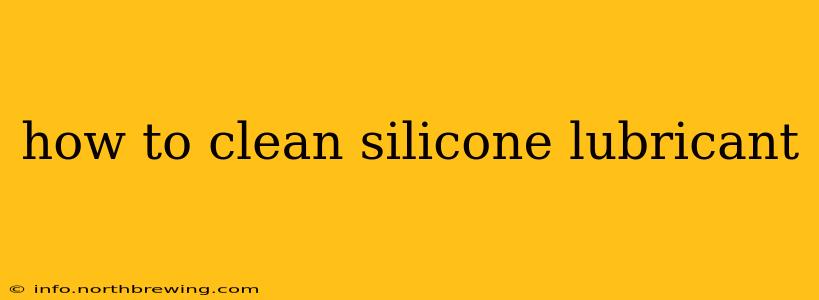Silicone lubricant, while incredibly useful for a variety of applications, can be messy. Knowing how to clean it effectively is crucial for maintaining cleanliness and preventing unwanted residue. This comprehensive guide will walk you through different methods and considerations, answering common questions along the way.
What are the Best Methods for Cleaning Silicone Lubricant?
The best method for cleaning silicone lubricant depends heavily on the surface you're cleaning. Different materials react differently to various cleaning agents. Generally, however, the following approaches are effective:
1. For Non-Porous Surfaces (e.g., Metal, Glass, Plastic):
-
Isopropyl Alcohol (IPA): IPA is a highly effective solvent for silicone and is readily available. Simply apply IPA to a clean cloth or paper towel, and gently wipe the affected area. Repeat as needed. For stubborn residue, allow the IPA to sit for a few minutes before wiping. Always test a small, inconspicuous area first to ensure the IPA doesn't damage the surface.
-
Soap and Water: For light silicone lubricant residue, warm soapy water can be sufficient. Use a soft cloth or sponge, and rinse thoroughly with clean water. This method is gentler than using solvents.
2. For Porous Surfaces (e.g., Fabric, Wood, Leather):
Cleaning silicone lubricant from porous surfaces is more challenging. The lubricant can seep into the material, making complete removal difficult. In these cases, focus on minimizing the visible residue rather than complete eradication:
-
Gentle Scrubbing: Use a soft brush and a mild detergent solution to gently loosen and remove as much silicone as possible. Avoid harsh scrubbing, which can damage the material.
-
Specialized Cleaners: For particularly delicate fabrics or materials, consider using a specialized cleaner designed for the specific material. Always test a small, hidden area first to check for compatibility.
-
Absorption: For some materials, you might be able to absorb excess silicone lubricant with an absorbent material like cornstarch or baking soda. Apply the absorbent material to the affected area, let it sit for a while, then brush it off.
What Solvents Should Be Avoided When Cleaning Silicone Lubricant?
While some solvents are effective, others can be harmful to the surface being cleaned or even dangerous to handle. Avoid using:
- Chlorinated solvents: These can be harsh and may damage certain materials.
- Strong acids or bases: These can cause chemical reactions and damage surfaces.
- Flammable solvents: Always work in a well-ventilated area when using solvents, and never use them near open flames.
How Do I Clean Silicone Lubricant from My Hands?
Silicone lubricant can be sticky and difficult to remove from skin. Thorough washing with soap and water is typically sufficient. If residue remains, try using a hand cleaner designed for removing grease and grime.
Can I Use a Pressure Washer to Clean Silicone Lubricant?
While a pressure washer might seem like a powerful cleaning option, it's generally not recommended for removing silicone lubricant. The high pressure can spread the lubricant further and damage the underlying surface.
What are Some Common Mistakes to Avoid When Cleaning Silicone Lubricant?
- Using abrasive cleaners: Abrasive cleaners can scratch delicate surfaces.
- Ignoring safety precautions: Always wear appropriate safety equipment when handling solvents.
- Using incompatible cleaners: Using the wrong cleaner can damage the surface being cleaned.
- Not testing on a hidden area first: Always test your chosen cleaning method on an inconspicuous area before applying it to the entire surface.
Conclusion
Cleaning silicone lubricant effectively requires understanding the material and the surface being cleaned. By employing the appropriate methods and avoiding common mistakes, you can successfully remove silicone lubricant and maintain a clean, functional environment. Remember to always prioritize safety and test any cleaning solution in an inconspicuous area first.
